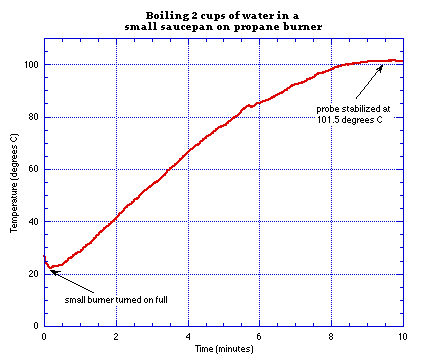
The initial calibration of the first 12 probes was done at a single point instead of a two-point calibration because we had run out of time. Even so the probes show a remarkable consistancy.
A CC Smart Temperature Probe uses the calibration information stored in the probes memory to normalize its response to that of an "ideal" probe. This means that after calibration all temperature probes should respond identically.
Here is the initial one point calibration data table:
| # | temp | desired reading | actual reading | offset correction |
| 1 | 20.1 | 1149 | 1156 | -7 |
| 2 | 20.0 | 1147 | 1154 | -7 |
| 3 | 20.0 | 1147 | 1141 | -6 |
| 4 | 20.05 | 1148 | 1158 | -10 |
| 5 | 20.0 | 1147 | 1134 | 13 |
| 6 | 20.05 | 1148 | 1153 | -5 |
| 7 | 20.05 | 1148 | 1152 | -4 |
| 8 | 20.05 | 1148 | 1137 | 11 |
| 9 | 20.0 | 1147 | 1145 | 2 |
| 10 | 20.0 | 1147 | 1139 | 8 |
| 11 | 20.0 | 1147 | 1136 | 11 |
| 12 | 19.9 | 1145 | 1145 | 0 |
The 12 bit analog-to-digital converter provides a little over 16 steps of resolution per degree C. Looking at the table above we can see that even uncalibrated the first twelve probes are within +/- one degree of each other at 20 degrees C (68 F).
After producing this table the offset correction was applied to each probe. A further test was performed comparing all the probes at 17 degrees C and 40. The maximum variance among all the calibrated probes measured in this range was only 0.2 degrees.
I performed the following test to both see how the adhesive-lined heat shrink tubing that protects the sensor works as well as to check the accuracy at 100 degrees C, boiling water.

I also wanted to make certain thhe probe operated at temperatures well below 0 so I put the probe in my freezer. The probe was placed in a full bottom freezer not touching anything solid -- it was in still air. It took almost 20 minutes for the probe to reach thermal equlibrium at -18.0 degrees.
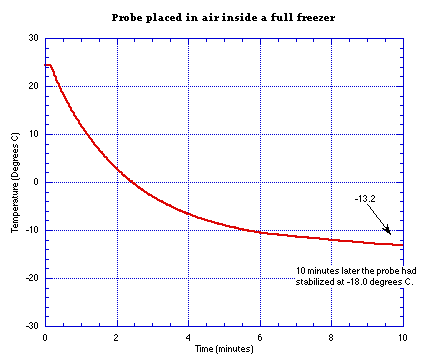
Here's the reverse experiment where I took the probe out of the freezer and left it in still air in the kitchen. It still takes almost 20 minutes to reach thermal equalibrium in still air.
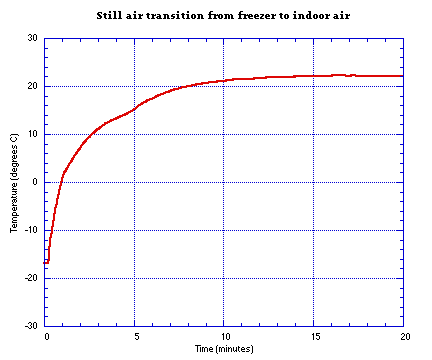
I was working late February 27 and when I was finished with the computer I decided to let the temperature probe collect data the rest of the night. I setup Data Logger to collect data for 8 hours and left it running with the temperature probe on my desk in my office. The next morning I saved the experiment data andplotted it in KaleidaGraph:
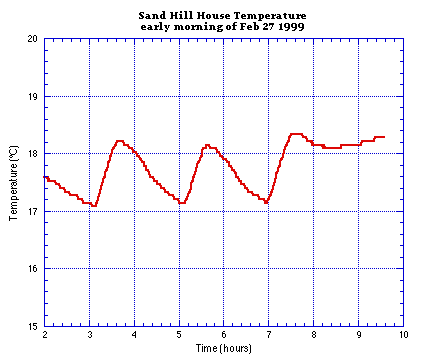
We built this house a year ago and I had never run an experiment like this before. The temperature outside during the night was aproximately -7 degrees Celcius (20 degrees F).
Each heating cycle took aproximately 35 minutes.
Each cooling cycle took aproximately 90 minutes or about 3 times as long as a heating cycle.
Since the heating portion is about 1/4 of the thermal cycle and the heat input from the furnace must equal the heat lost by the house during the entire thermal cycle the house must lose heat at about 1/4 the rate that the furnace delivers heat.
The furnace delivers aproximately 60,000 BTUs/hour therefore the house loses about 15,000 BTUs/hour with a 20 degree C difference in temperature between the inside and the outside.
In other words the house loses 750 BTUs per hour per degree C difference of temperature or about 420 BTUs/hour/degreeF
Notice what didn't happen around 8 in the morning -- there was no heat cycle! The sun had come up and was now contributing a great deal of solar gain towrads the heating needs of the house.
Here's a picture of the house just after it was completed. There are a large number of south facing windows. This wall actually faces 15 degrees east of due south which means the solar gain is optimized more for morning collection.

We have a heat balancing valve in our shower. This valve is supposed to keep the shower water at a constant temperature even if the flow rate or temperature of the hot and cold water supply lines varies. This valve is required on all new construction becuase it can prevent dangerous injuries where the water in a shower gets dramatically hotter when the flow of cold water drops (perhaps because someone turned on a washing machine).
I had noticed that the temperature wasn't always stable; sometimes it would get hotter or colder. I used black electrical tape to fix the temperature probe to the shower head so that the sensor end was in the shower stream, started data collection and turned on the shower to the normal handle position I use. Here's the graph:
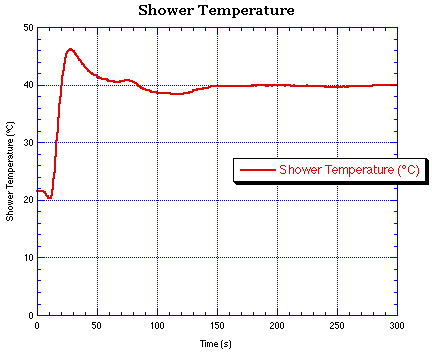
Initially there is almost a 7 degree C overshoot as the water gets too hot. Then the temperature drops to near the stable value, pauses, and then drops lower below the stable value. Only after about 2 1/2 minuutes does the water temperature stabilize. So it wasn't just my imagination. I wonder if other shower heat balancing valves do this also.